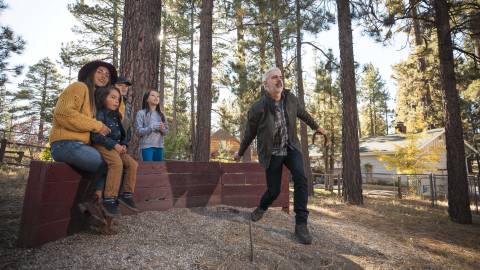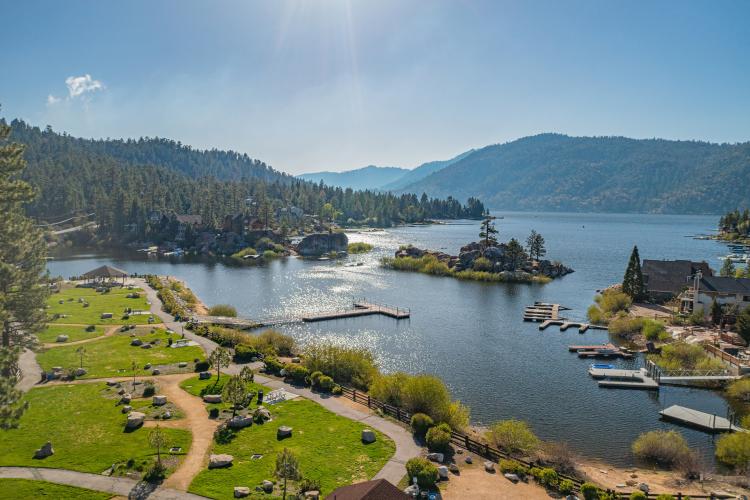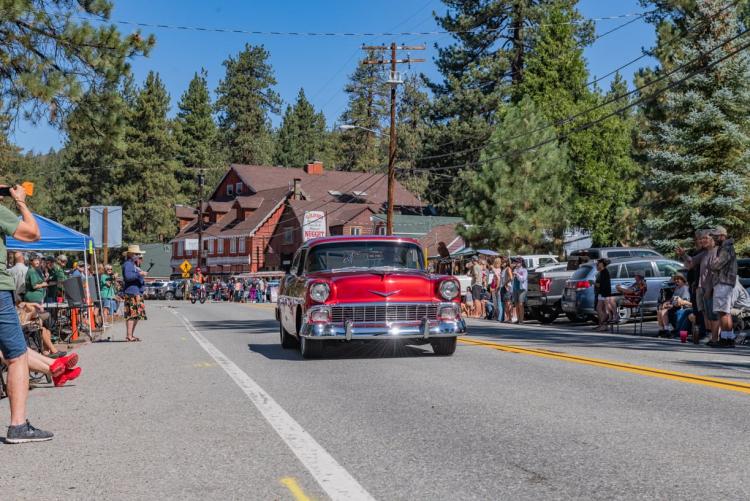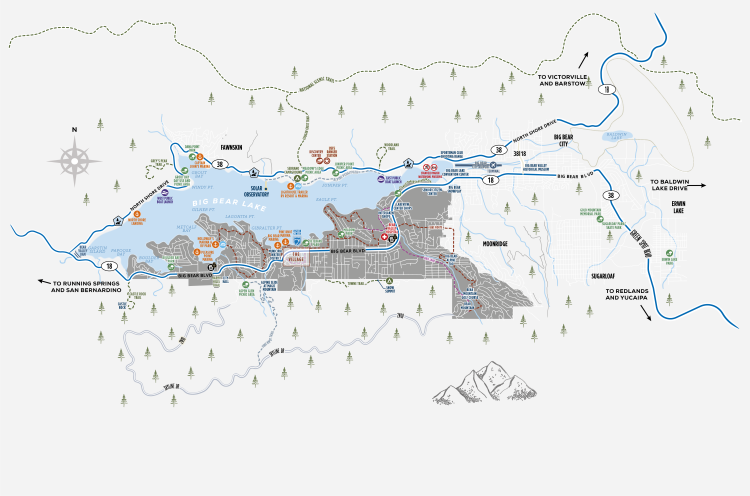
Places To Stay: Big Bear's Cozy Neighborhoods
Posted: 11/01/23
When booking your cabin rental in Big Bear, get to know the different neighborhoods and the quirks and characteristics of each.
So...you've decided that Big Bear is the right place for your next getaway, great choice! Now, where to book your cabin rental stay is the next question and what part of Big Bear is best to stay?
Click image to enlarge.
City of Big Bear Lake Neighborhoods
The valley's only municipality sits central and includes amenities such as the Lake and marinas, Snow Summit and Bear Mountain ski resorts, snow tubing parks, city parks, grocery stores, and The Village.
Vacation rental homes in this area tend to avoid steep drives making winter driving in the area more manageable. Also, being centrally located, you can easily keep your car parked during your stay and use the Free Big Bear Trolley public transit to access most amenities, recreation, and dining.
Moonridge
The lower part of the Moonridge neighborhood sits within the City of Big Bear Lake. Lower Moonridge includes amenities like Big Bear Alpine Zoo, the Bear Mountain Golf Course, the Bear Mountain Ski Resort, and the newly refurbished Moonridge Strip with dining and shopping along Moonridge Rd. Hiking along Skyline Trail, Bristlecone Trail, and the 2N10 fire road are also accessible from the area. Lower Moonridge homes tend to be located on flatter terrain close to central Big Bear.
Upper Moonridge encompasses a mountainous area with some of the best hilltop views in the valley. Imagine sitting on the deck with your morning coffee and taking in the views of Big Bear Lake and the ski resorts all at once. While Upper Moonridge is a quiet, forested, and more residential neighborhood, the steeper streets and driveways can make winter access to some homes challenging, especially if your vehicle does not feature four-wheel or all-wheel drive.
Fox Farm
The Fox Farm neighborhood boarders Lower Moonridge to the east. Named after the fox farms that occupied the area from the 1920s-40s, this location enjoys level roads that wind through a quiet neighborhood close to Big Bear Blvd amenities. The Fox Farm neighborhood sees a lot of care in landscaping and curb appeal making the area ideal for strolls with family or your dog. A fall season jaunt is particularly dazzling with the area's many changing aspens and oaks.
Boulder Bay
This quiet neighborhood backs up to the iconic Boulder Bay inlet of the lake. The area is particularly scenic and close-by to amenities such as Pleasure Point Marina, the refurbished Boulder Bay Park, dining, and the famed Castle Rock Trail. It's worth noting that this area sees heavy traffic during peak visitation periods.

Boulder Bay Park in Big Bear Lake, CA (Bending Energy Photography)
Fawnskin
Fawnskin on the North Shore offers a taste of Big Bear's rustic history. The quaint "downtown" area includes a post office, Fire Station, general store, a single North Shore Cafe restaurant, an outdoor sporting goods store, and Captain John's Marina just down the road. The area backs up to the National Forest with the Grays Peak Trailhead and Grout Bay Picnic Area nearby. The 3N14 'Rim of the World' fire road leads to the Hanna Flat Campground and hiking trail through unique high desert terrain. Please note that the Fawnskin area includes some steep and winding roads that can be challenging to navigate.

Downtown Fawnskin during the annual Fun Run Car Show (Bending Energy Photography)
Big Bear's East Valley Neighborhoods
Once you drive east past Division Rd, you've hit the unincorporated Big Bear City area with several neighborhoods each with their own charm and landscape. The area is worth an explore to see Big Bear's equestrian land and lesser visited amenities.
Sugarloaf
Sugarloaf is tucked away in a heavily forested area offering the opportunity for more privacy and seclusion. A local park features an expansive jungle-gym, skate park, and even BMX park. The newly finished Maple Hills Trail system next door to Big Bear High School also invites visitors on foot or on a bike. You won't want to miss a chance to dine at Kallan's Bar & Grill. This local bar gives a very divey vibe with a pool table and jukebox for patrons to enjoy. And for just the necessities, Easy's General Store across the street carries a host of goods and supplies.
Baldwin Lake
Baldwin Lake is Big Bear's most rural and ranch-like area and is home to the valley's biggest population of wild burros. Amenities worth experiencing are horseback rides and the petting zoo at Baldwin Lake Stables and the pebble plains habitat at the Baldwin Lake Ecological Reserve. This unique ecosystem of plants dates back to the Ice Age and isn't replicated anywhere else in the world!
